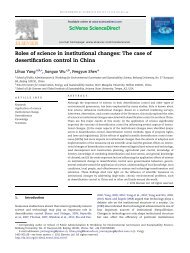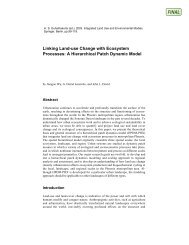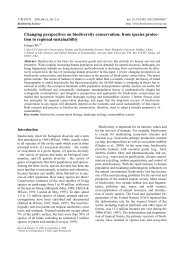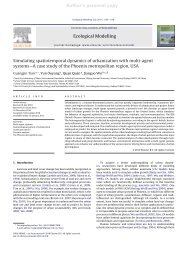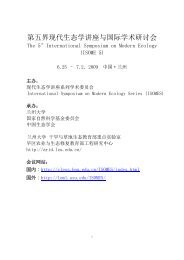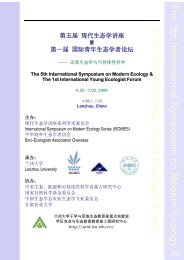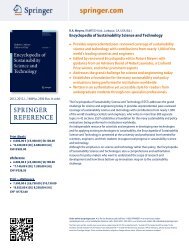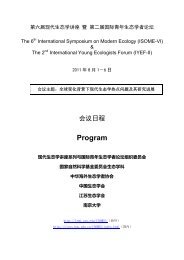238 BERLING-WOLFF AND WU parks and inner-city open lands so that a minimum habitat connectivity can be maintained. In addition, the location and spatial arrangement of parks and open spaces are also critically important. For example, these habitat patches should be situated in such a way as to create corridors in the increasingly fragmented landscape. An important value of PHX-UGM lies in its ability to incorporate different protection schemes, population growth rates and population density measures. Decision makers and land use planners may design an open space network, incorporate it into a model scenario, and then quantitatively assess habitat connectivity using landscape metrics. This may provide useful information for land-swap deals, such as trading specific state land tracts for desirable inner-city tracts to create parks. If an ecologically healthy Phoenix urban environment is to be maintained, time is running out on many of the options still available to city planners. The residents of the Phoenix Metro area have demonstrated repeatedly that they are opposed to further increasing population density or rapid urban sprawl. Growth management initiatives have been repeatedly voted down and developers have thwarted the legislature in their efforts to create growth management legislation. These facts indicate that if the area is to continue growing and if a reasonable quality of life is to be maintained, a new mindset will need to be adopted. As our model results suggest, this would require the strict regulation and careful planning of open spaces, as well as significantly increasing population densities in the developed areas. Acknowledgments We would like to thank Matt Luck, Darrel Jenerette, and John David at the Landscape Ecology and Modeling Laboratory (LEML) of Arizona State University for their assistance during the project. Suggestions and comments from Charles Wolff, G. Pontius, Jr., R. Quay, C. Redman, and N. Grimm are also greatly appreciated. This research was supported in part by grants from the U.S. Environmental Protection Agency’s Science to Achieve Results program (R827676-01-0), and US National Science Foundation (DEB 97-14833, CAP-LTER). References Batty, M. (1979) Progress, success, and failure in urban modelling. Environment and Planning A 2, 863–878. Batty, M. (1994) A chronicle of scientific planning: The anglo-american modeling experience. Journal of the American Planning Association 60, 7–16. Batty, M., Longley, P. and Fotheringham, S. (1989) Urban growth and form: Scaling, fractal geometry, and diffusion-limited aggregation. Environment and Planning A 21, 1447–1472. Batty, M. and Xie, Y. (1994) From cells to cities. Environment and Planning B 21, S31–S48. Berling-Wolff, S. and Wu, J. (2004) Urban growth models: A historical review. Ecological Research 19, 119–129. Breuste, J., Feldmann, H. and Uhlmann, O., eds. (1998) Urban Ecology. <strong>Springer</strong>, Berlin. Clarke, K.C., Hoppen, S. and Gaydos, L. (1997) A self-modifying cellular automaton model of historical urbanization in the San Francisco Bay Area. Environment and Planning B 24, 247–261. Congalton R.G. and Green, G. (1999) Assessing the Accuracy of Remotely Sensed Data: Principles and Practices. Lewis Publishers, Boca Raton. Costanza, R. and Maxwell, T. (1994) Resolution and predictability: An approach to the scaling problem. Landscape Ecology 9, 47–57.
MODELING URBAN LANDSCAPE DYNAMICS 239 Couclelis, H. (1985) Cellular worlds: A framework for modeling micro-macro dynamics. Environment and Planning A 17, 585–596. Ellfman, T. (1997) Infill: The Cure for Sprawl? Accessed 8 November 2002, www.urbanfutures. org/abstract.cfm. Foresman, T.W., Pickett, S.T.A. and Zipperer, W.C. (1997) Methods for spatial and temporal land use and land cover assessment for urban ecosystems and application in the Greater Baltimore-Chesapeake Region. Urban Ecosystems 1, 201–216. Gammage, G., Jr. (1998) Phoenix in Perspective: Reflection on Developing the Desert. Herberger Center for Design Excellence, Arizona State University, Tempe AZ. Gordon, P., Richardson, H., Donghwan, A. and O’Brien, T. (2000) The Economic Effects of Arizona’s Proposed Citizen’s Growth Management Initiative. www.azchamber.com/commerce/Gordon.pdf. Grant, W., Pedersen, E.K. and Marin, S.L. (1997) Ecological & Natural Resource Management Systems Analysis and Simulation. John Wiley & Sons, Inc., New York. Gustafson, E.J. (1998) Quantifying landscape spatial pattern: What is the state of the art? Ecosystems 1, 143–156. Guhathakurta, S., ed. (2003) Integrated Land Use and Environmental Models. <strong>Springer</strong>, Berlin. Harris, B. (1985) Urban simulation models in regional science. Journal of Regional Science 25, 545–567. Harris, B. (1994) The real issues concerning Lee’s ”requiem”. Journal of the American Planning Association 60, 31–34. Jelinski, D.E. and Wu, J. (1996) The modifiable areal unit problem and implications for landscape ecology. Landscape Ecology 11, 129–140. Jenerette, D.G. and Wu, J. (2001) Analysis and simulation of land-use change in the Central Arizona–Phoenix Region. Landscape Ecology 16, 611–626. Kirtland, D., Gaydos, L., Clarke, K., DeCola, L., Acevedo, W. and Bell, C. (1994) An analysis of human-induced land transformations in the San Francisco Bay/Sacramento Area. World Resources Review 6, 206–217. Knowles-Yanez, K., Morizt, C., Fry, J., Bucchin, M., Redman, C.L. and McCartney, P. (1999) Historic Land Use Team: Phase I Report on Generalized Landuse. Central Arizona Phoenix LTER: Phoenix, Arizona, USA. Landis, J.D., Monzon, J.P., Reilly, M. and Cogan, C. (1998) Development and Pilot Application of the California Urban and Biodiversity Analysis (CURBA) Model. http://gis.esri.com/ library/userconf/proc98/PROCEED/TO600/PAP571/P571.htm. Lee, D.B., Jr. (1973) Requiem for large-scale models. Journal of the American Institute of Planners 40, 163–178. Lee, D.B., Jr. (1994) Retrospective on large-scale urban models. The Journal of the American Planning Association 60, 35–40. Lee, J., Tian, L., Erickson, L.J. and Kulikowski, T.D. (1998) Analyzing growth-management policies with geographical information systems. Environment and Planning B 25, 865–879. Luck, M. and Wu, J. (2002) A gradient analysis of the landscape pattern of urbanization in the Phoenix metropolitan area of USA. Landscape Ecology 17, 327–339. Maricopa County Comprehensive Plan (1997) www.maricopa.gov/planning/compln/ COMPLAN.asp.htm McGarigal, K. and Marks, B.J. (1995) FRAGSTATS: Spatial Pattern Analysis Program for Quantifying Landscape Structure. Gen. Tech. Rep. PNW-GTR-351. Pacific Northwest Research Station, USDA-Forest Service, Portland. Morrison Institute For Public Policy (2000) Hits and Misses: Fast Growth in Metropolitan Phoenix. School of Public Affairs, Arizona State University. www.asu.edu/copp/morrison. O’Neill, R.V., Krummer, J.R., Gardner, R.H., Sugihara, G., Jackson, B., DeAngelis, D.L., Milne, B.T., Turner, M.G., Zygmunt, B., Christensen, S.W., Dale, V.H. and Graham, R.L. (1988) Indices of landscape pattern. Landscape Ecology 1, 153–162. Oreskes, N., Shrader-Frechette, K. and Belitz, K. (1994) Verification, validation, and confirmation of numerical models in the earth sciences. Science 263, 641–646. Pickett, S.T.A., Burch, J., Dalton, S.E., Foresman, T.W., Grove, J.M. and Rowntree, R. (1997) A conceptual framework for the study of human ecosystems in urban areas. Urban Ecosystems 1, 185–199. Pickett, S.T.A. and Cadenasso, M.L. (1995) Landscape ecology: Spatial heterogeneity in ecological systems. Science 269, 331–334. Pickett, S.T.A., Cadenasso, M.L., Grove, J.M., Nilon, C.H., Pouyat, R.V., Zipperer, W.C. and Costanza, R. (2001) Urban ecological systems: Linking terrestrial ecological, physical, and socioeconomic components of metropolitan areas. Annual Review of Ecology and Systematics 32, 127–157.




